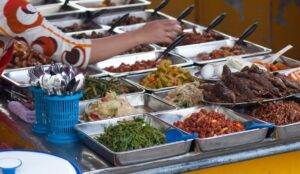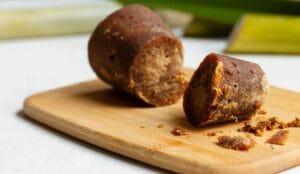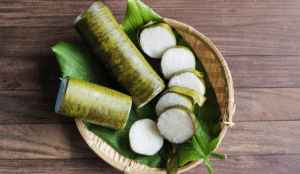Top 10 Irresistible Malaysia Biscuits You Should Try
When you think about the heartbeat of a Malaysian home, you might picture the smell of sambal on the stove or the clinking of ice in a glass of teh tarik. But tucked away in nearly every kitchen cabinet—next to the instant noodles and 3-in-1 coffee—you’ll find a comforting, familiar presence: Malaysia biscuits.
Whether for dunking in your morning kopi, satisfying late-night cravings, or offering guests during festive visits, biscuits are more than just snacks—they’re part of our daily lives. Over the decades, many iconic biscuit brands and flavors have become household staples across the country.
This list celebrates the famous biscuits in Malaysia that deserve a place in every pantry. From traditional favorites to modern classics, these crunchy treats are uniquely Malaysian in their history, taste, and nostalgic value.
Frequently Asked Questions (FAQ)
1. What is the most popular snack in Malaysia?
One of the most popular snacks in Malaysia is keropok (crispy crackers), especially keropok lekor from Terengganu—a chewy, fish-based cracker that’s fried and served with spicy sauce. Other favorites include pisang goreng (fried banana), curry puffs, and traditional kuih-muih like kuih lapis and onde-onde. Malaysians love snacking, especially on flavorful, bite-sized treats that reflect the country’s diverse food heritage.
2. What is the world's most famous biscuit?
Globally, the Oreo is often considered the most famous biscuit. It’s recognized in over 100 countries and known for its chocolate sandwich cookies with a sweet cream filling. Whether dunked in milk or used in desserts, Oreos are a snack staple around the world.
3. What is the most common type of biscuit?
The most common type of biscuit varies by region. In Malaysia, Marie biscuits and cream crackers are household staples—often eaten with coffee or Milo. In the UK, digestive biscuits are very popular, while in the US, “biscuits” refer to soft, fluffy bread rolls. But overall, plain, slightly sweet biscuits like Marie or digestive are among the most commonly consumed globally.
4. What are the most popular English biscuits?
Some of the most popular English biscuits include:
- Digestive biscuits – slightly sweet and crumbly
- Rich Tea – light, crisp, and perfect for dunking
- Jammie Dodgers – filled with raspberry jam
Custard Creams – vanilla cream sandwiched between patterned biscuits
These are classic choices often enjoyed with a cup of tea, a key part of British snack culture.
5. What is the most traditional food in Malaysia?
The most traditional food in Malaysia is Nasi Lemak. It’s a fragrant rice dish cooked in coconut milk, served with spicy sambal, fried anchovies, boiled egg, peanuts, and cucumber. It’s eaten for breakfast, lunch, or dinner and loved across all ethnic groups. Nasi Lemak represents the essence of Malaysian flavor—rich, spicy, and deeply satisfying.
1. Hup Seng Cream Crackers – The Everyday Essential
If there’s one biscuit that unites generations of Malaysians, it’s the humble Hup Seng Cream Cracker. Found in almost every home, office pantry, and even kopitiam, these crackers are the ultimate in versatility.
They’re slightly salted, satisfyingly crunchy, and pair perfectly with kaya, butter, jam, or just dipped in hot Milo. Their long shelf life and affordability make them a true pantry hero.
No list of Malaysia biscuits is complete without them. For many, the blue-and-white tin is a symbol of home comfort.
2. Julie’s Peanut Butter Sandwich Biscuits – A Childhood Favourite
Julie’s is a homegrown Malaysian brand that has gone international, and their peanut butter sandwich biscuits are among their top sellers. Two golden crackers with a thick layer of creamy peanut butter in between—it’s a simple, satisfying combo that kids and adults love.
The sweet-salty balance is just right, and the convenient packaging makes them perfect for school lunches, road trips, or late-night study snacks.
Julie’s has become synonymous with quality and nostalgia in the world of Malaysia biscuits.
3. Jacob’s Weetameal Biscuits – The "Healthy" Snack
Let’s be honest—Malaysians love to snack. But we also like to pretend we’re being healthy while doing it. Enter Jacob’s Weetameal, often dubbed the “healthier” option in the biscuit aisle.
These slightly sweet, wheaty biscuits are rich in fiber and vitamins, making them a go-to for breakfast or a guilt-free nibble. Paired with coffee or topped with a banana slice, Jacob’s gives you the illusion of eating clean—while still getting your biscuit fix.
Among the famous biscuits in Malaysia, Jacob’s stands out for its wholesome image.
4. Tiger Biscuits by Mondelez – Childhood in a Wrapper
There’s something deeply nostalgic about tearing open a red Tiger biscuit wrapper. Simple, sweet, and subtly vanilla-flavored, these biscuits have fed generations of Malaysian schoolkids.
Back in the day, Tiger biscuits were often given as pocket money treats or slipped into lunchboxes. Today, they’re still loved for their classic taste and affordability. Whether eaten alone or dunked in milk, they’re a timeless addition to the world of Malaysia biscuits.
5. Khong Guan Assorted Biscuits – Festive Must-Have
If you’ve ever visited someone’s house during Chinese New Year or Hari Raya, chances are you’ve seen the iconic red tin of Khong Guan biscuits. A family-size tin filled with assorted flavors—jam-filled, sugar-coated, chocolate-dipped—it’s like a biscuit party in a box.
Part of the fun is never quite knowing which biscuit you’ll pull out next. The variety and tradition associated with this tin make it more than just a snack—it’s a cultural symbol.
No list of famous biscuits in Malaysia would be complete without this festive classic.
6. Biskut Marie (Marie Biscuits) – Simplicity at Its Best
Marie biscuits are a staple across many cultures, and in Malaysia, they’ve taken on a life of their own. These round, slightly sweet, golden-brown biscuits are used in everything—from dunking to baking.
In fact, one of the most beloved no-bake Malaysian desserts is kek batik—a rich chocolate cake layered with Marie biscuits. The texture and neutral flavor make it the perfect biscuit for both snacking and dessert-making.
A pantry stocked with Malaysia biscuits almost always has a pack of Maries ready for action.
7. Ping Pong Biscuits (Biskut Ping Pong) – The Crunchy Crowd-Pleaser
Found mostly in traditional biscuit shops or kuih stalls, Ping Pong biscuits are small, round, and packed with nostalgic charm. Their crispy texture and slightly sweet flavor make them addictive—and because they’re bite-sized, it’s easy to lose count of how many you’ve eaten.
Often sold by weight and scooped into plastic bags or containers, these biscuits remind us of childhood trips to the kedai runcit. They may not come in fancy packaging, but their taste and crunch earn them a well-deserved spot in the hall of famous biscuits in Malaysia.
8. Biskut Kelapa (Coconut Biscuits) – A Tropical Treat
Malaysians love their coconut, and it’s no surprise that it has made its way into the world of biscuits. Biskut Kelapa are sweet, aromatic, and slightly chewy, offering a taste of tropical comfort in every bite.
Perfect with hot kopi or as an after-meal treat, these biscuits are often homemade or sold in traditional snack shops. They’re a great example of how local flavors infuse the landscape of Malaysia biscuits.
If you’re looking to stock your pantry with something a little different yet deeply Malaysian, Biskut Kelapa is a must.
9. London Almond Biscuits – Festive Luxury
A modern addition to the biscuit scene, London Almond biscuits have become wildly popular during festive seasons like Hari Raya and Chinese New Year. These buttery cookies are filled with almonds, coated in chocolate, and topped with colorful sugar sprinkles.
Rich, indulgent, and best enjoyed with tea, they represent the more luxurious side of Malaysia biscuits. Often homemade or found in festive hampers, London Almonds are perfect for entertaining guests or treating yourself to something special.
10. Biskut Bangkit – A Taste of Heritage
Soft, powdery, and fragrant with coconut or pandan, Biskut Bangkit is a traditional biscuit with deep roots in Malaysian culture. It’s especially popular during Hari Raya, and biting into one feels like stepping back in time.
The biscuit literally melts in your mouth, leaving a subtle sweetness behind. Often molded into floral shapes, Biskut Bangkit is both beautiful and delicious. It’s a proud representative of the famous biscuits in Malaysia that carry cultural and historical significance.
The Emotional Connection: Why Biscuits Matter
While biscuits may seem like small, everyday items, they hold a surprising amount of emotional weight for many Malaysians. They’re tied to childhood memories, festive gatherings, road trips, and quiet moments of tea-time reflection.
When someone offers you Malaysia biscuits, it’s rarely just about food—it’s about hospitality, care, and connection. That’s why stocking your pantry with Malaysia biscuits is more than just preparing for guests. It’s about keeping a slice of tradition, comfort, and joy always within reach.
Whether shared during a celebration or enjoyed alone, Malaysia biscuits are a beloved symbol of everyday warmth.
Regional Flavours and Local Makers
While many mass-market brands dominate the biscuit shelves, don’t overlook smaller, regional producers who craft unique versions of classic Malaysia biscuits. In places like Melaka, Kota Bharu, and Kuching, you’ll find local shops making handmade Malaysia biscuits like Biskut Arab, Biskut Kelapa, and Kuih Sepit that are just as worthy of a spot in your pantry.
These artisans often use time-honored recipes, passed down from grandparents, with ingredients sourced locally. Supporting them not only adds variety to your Malaysia biscuits collection, but also helps preserve culinary heritage.
Pairing Biscuits with Local Drinks
One of the best things about biscuits is their ability to enhance your favorite Malaysian beverages. Here are some pairing ideas:
- Hup Seng Cream Crackers + Teh Tarik – A classic combo that never gets old.
- Julie’s Peanut Butter Sandwich + Kopi O – A sweet-salty contrast that balances the bitter strength of black coffee.
- Marie Biscuits + Milo – Childhood in every dunk.
- Biskut Bangkit + Pandan Tea – Light and aromatic, a true heritage pairing.
Biscuits and drinks are an inseparable part of Malaysian food culture. Together, they create everyday rituals we return to again and again.
The Evolving Scene: Biscuits Go Gourmet
As tastes evolve, so does the biscuit scene in Malaysia. Today, you can find gourmet Malaysia biscuits from brands experimenting with local flavors—think matcha-pandan, gula melaka-coconut, and durian cream-filled crackers.
Artisan bakers are elevating traditional Malaysia biscuits, while modern brands like Kintry and The Skinny Bakers are blending heritage and innovation. These creative takes show that the love for Malaysia biscuits isn’t fading—it’s growing into new, exciting directions.
So whether you’re a fan of old-school favorites or eager to try bold new flavors, the Malaysia biscuits world has something for you.
Building Your Biscuit Pantry: Final Tips
If you’re looking to stock your pantry with the essentials, here’s how to keep it well-rounded with a variety of Malaysia biscuits:
Staple Crackers – Cream crackers, Marie, and Weetameal for daily snacking.
Flavored Treats – Peanut butter sandwiches, coconut biscuits, and chocolate-coated options that represent modern takes on classic Malaysia biscuits.
Festive Favorites – Biskut Bangkit, London Almonds, and Khong Guan tins for special occasions or holiday feasts.
Homemade and Heritage – Pick up locally made versions of Malaysia biscuits when visiting small towns or festive bazaars.
Having a biscuit for every occasion—be it comfort, celebration, or nostalgia—is what makes a Malaysia biscuits pantry feel complete.
Conclusion: A Crunchy Slice of Malaysian Life
Biscuits may be small, but in Malaysia, they carry big meaning. They connect generations, bring joy to ordinary days, and add sweetness to special moments. Whether mass-produced or handmade, sweet or savory, these pantry staples reflect the flavors, history, and warmth of Malaysian life.
So the next time you open your pantry, take a moment to appreciate those humble packages of Malaysia biscuits. They’re more than snacks—they’re edible memories.
And if your shelves are missing any of these famous biscuits in Malaysia, maybe it’s time for a trip to the nearest kedai runcit. Happy snacking!
Posts you might be interested
-
 Why Rural Development Matters/0 Comments
Why Rural Development Matters/0 Comments -

-






